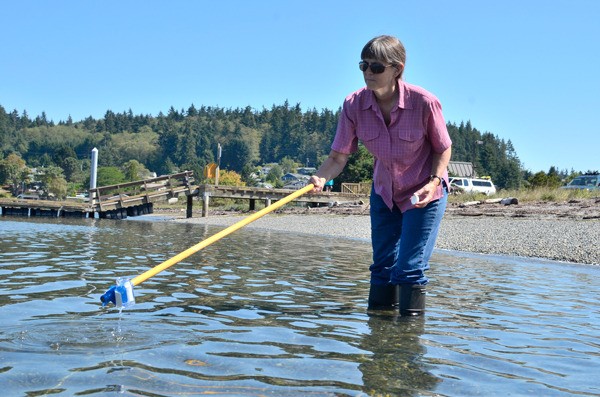Despite the temporary opening of shellfish harvesting in Holmes Harbor this spring, the first in nine years, it doesn’t appear the area’s designation as a shellfish protection district will go away any time soon.
In fact, the district, which was created years ago to combat high levels of pollution that now largely don’t exist, may remain indefinitely.
“We’ve actually never had a shellfish protection district dissolved,” said Scott Berbells, a shellfish growing area section manager with the state Department of Health. “They just become inactive.”
The reason is because state law is clear about how and when to create protection districts, but not the process for doing away with them. For county health officials who have spent years addressing the problem, it’s a frustrating reality. Water quality has improved dramatically, yet the prize — a green light from state regulators that would pave the way for the removal of the emergency measure — remains out of reach.
“Yeah, I think it should be lifted,” said Keith Higman, director of Island County Public Health. “It serves no useful purpose to the area.”
“It’s a black eye,” he added. “It makes it look like we live in a polluted environment and I don’t think we do.”
Holmes Harbor was closed to shellfish harvesting and swimming in 2006 when a required water quality test from an application to commercially harvest geoducks revealed high levels of fecal coliform bacteria. The closures led to the formation of the Holmes Harbor Shellfish Protection District in March 2007 by the Island County commissioners. It was a step required by state law due to the water quality findings.
To fight the problem, the county implemented a scoop-the-poop campaign to reduce dog waste at Freeland Park, had hundreds of home septic systems inspected and required fixes where needed, and continued regular water quality testing at outfalls and on the shoreline. The efforts paid off, greatly improving water quality, but for occasional and mysterious spikes of enterococci, a form of bacteria found in all mammals.
“We still have this anomaly in the summertime and we don’t know what it is,” Higman said.
Over the past two years, the spikes have occurred suddenly in mid-July. Water quality results will be well within state parameters, but then the very next week levels will skyrocket to the highest possible level on the scale, Higman said.
The common belief is that wrack, seaweed and debris that accumulates in large quantities on the beach, is the primary source but nothing has been definitively proved. And though water quality has improved overall, it’s this spike that has state regulators worried and led to something of a stalemate, according to Jill Wood, director of environmental health, a division of Island County Public Health.
“Every time we talk [with the state] about a shellfish protection district it’s a predictable conversation,” Wood said. “They know our position, what we’ve accomplished.”
Berbells said the spike’s origin may be unknown, but it’s still a legitimate concern. The county has taken steps that have led to improvement, the basis for the temporary opening earlier this year, but there’s still work to be done, he said.
“There have been some improvements, but we’re not back to where we started,” Berbells said.
Even if the offending spikes were solved, Berbells said water quality is temperamental and the agency is concerned problems would reemerge if the programs created to address them were stopped. Also, there simply is no outline in state statutes for how to dissolve a district after it’s been formed, he said.
There are currently 18 shellfish protection districts in Western Washington. Fourteen are active and four inactive, according to Berbells.
Another complicating factor is the recent discovery of varnish clams in Holmes Harbor. An invasive species in Washington, they took root in the area during the closure and are now out-competing native species, such as Manila clams. Their presence brings the state Department of Fish and Wildlife into the conversation in a big way.
Higman said shellfish protection districts can be necessary and do much good, but he questions whether they need to exist forever simply because the process for their removal isn’t spelled out in state law. There needs to be clearer “targets” and “endpoints” rather than just a broad directive to fix the problem, he said.
Adding to county health officials’ frustration is that the spikes are known because the department elects to perform regular water quality testing. It’s not a requirement, according to Higman.
“It’s our data that’s generating their concern,” Higman said. “We might suffer from too much information,” he added.
Island County Commissioner Helen Price Johnson said she’s frustrated by the delay as well, and that the county is advocating for the approval that would allow the board to dissolve the district.
“I feel like we’ve done everything the state has asked us to do,” she said.
Price Johnson also said she felt confident that the county has the “pieces in place” to continue to manage its own waters effectively without the state oversight that comes with a shellfish protection district.



